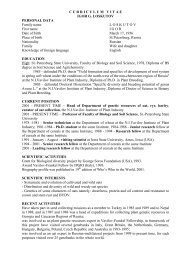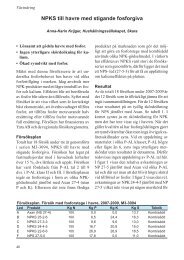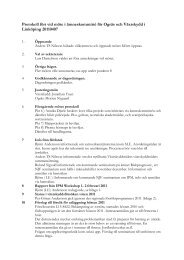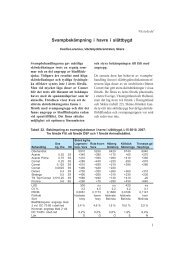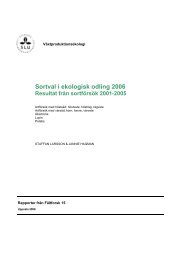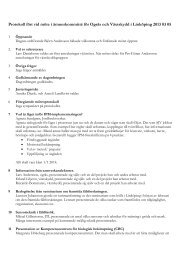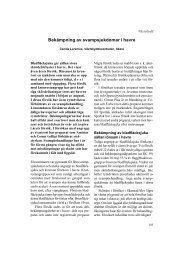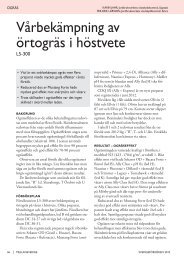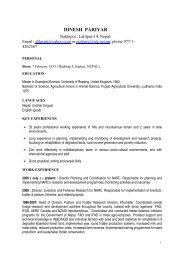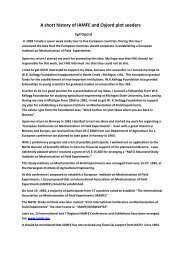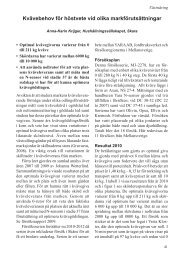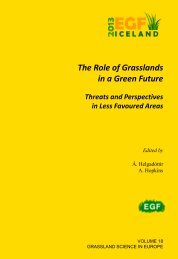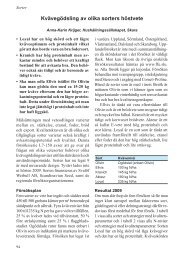ØYJORD PLOT SEEDERS Egil Øyjord
ØYJORD PLOT SEEDERS Egil Øyjord
ØYJORD PLOT SEEDERS Egil Øyjord
You also want an ePaper? Increase the reach of your titles
YUMPU automatically turns print PDFs into web optimized ePapers that Google loves.
<strong>ØYJORD</strong> <strong>PLOT</strong> <strong>SEEDERS</strong><br />
<strong>Egil</strong> <strong>Øyjord</strong><br />
During the winter 1957/58 research assistent <strong>Egil</strong> <strong>Øyjord</strong>, employed by the<br />
Committee on Mecanization of Field Experiments, Norwegian Institute of<br />
Agricultural Engineering, Vollebekk, Ås, designed a 10-row plot seeder for front<br />
mounting on an Agria 1700 two wheeled garden tractor. This seeder was put into<br />
operation in the spring of 1958 at Vollebekk research farm, belonging to the<br />
Agricultural University of Norway (NLH), now named Norwegian University of<br />
Life Sciences.<br />
During the winter 1958/59 Mr. <strong>Øyjord</strong> designed a 4-row and a 6-row plot seeder.<br />
These seeders were exhibited at a great agricultural show in Oslo in 1959.<br />
During the winter1959/60 Mr. <strong>Øyjord</strong> designed improved 4- row and a 10 -row<br />
plot seeders.<br />
In the spring of 1960 these two plot drills were put in operation at the State<br />
Experimental Farm , Møystad, Norway. Very successful results were obtained and<br />
it was decided that these seeders should be put into production.<br />
During the winter 1960/61, 20 units of the 10- row seeders and 5 units of the 4-row<br />
seeders were manufactured at Jens A. Schou Mek Verksted, Drobak, Norway .<br />
These seeders were delivered and successfully put into operation at Norwegian<br />
research stations in the spring of 1961.<br />
In 1964 representatives of 17 countries participated in “NATO Advanced Study<br />
Institute on Mechanization of Field Experiments” arranged in Norway.<br />
”The International Association on Mechanization of Field Experiments (IAMFE)”<br />
was founded. Since the start in 1964 the main objective of IAMFE has been to<br />
promote development on mechanization of plant breeding and agronomic trials.<br />
In order to follow up the demand and development of the <strong>Øyjord</strong> tractor mounted<br />
and self–propelled plot seeders, Mr. <strong>Øyjord</strong> established and operated the <strong>Øyjord</strong><br />
Research Laboratory at Jens A. Schou Mek Verksted from 1966 to 1976.<br />
The research in the <strong>Øyjord</strong> Research Laboratory as well as the tools and moulds<br />
for production of the <strong>Øyjord</strong> plot seeders were paid for by the sale of the seeders.<br />
The <strong>Øyjord</strong> plot seeders were exported from Norway to 57 countries all over the<br />
world. I refer to the enclosed information and quotation of letters from the users.<br />
In a letter of November 13. 1970, the winner of the Nobel Peace Prize 1970,<br />
Dr. Norman E. Borlaug wrote to me:<br />
..”It will be a pleasure to work with you and IAMFE in the furtherance of the green<br />
revolution”.<br />
In a statement of December 22, 1970, Dr. Borlaug wrote:<br />
..”The small plot seeders have been very helpful in increasing the reliability of<br />
experimental results in India, Tunisia, Lebanon, etc”<br />
From 1974 to 1976 Mr. <strong>Øyjord</strong> transferred the production of <strong>Øyjord</strong> plot seeders<br />
from JensA.Schou Mek. Verksted, Norway to the Wintersteiger factory in Austria.<br />
Mr. <strong>Øyjord</strong> used the royalties from the export of <strong>Øyjord</strong> plot seeders as a financial<br />
source for support of the IAMFE activities (www.iamfe.org ) and for the start of<br />
IAU (www.iau-hub.org ).<br />
1
QUOTATIONS OF LETTERS TO PROFESSOR EGIL <strong>ØYJORD</strong> AND JENS A.<br />
SCHOU MEK. VERKSTED FROM USERS OF THE <strong>ØYJORD</strong> <strong>PLOT</strong><br />
<strong>SEEDERS</strong>.<br />
(Some other statements have also been added )<br />
Compiled by Antonio Wilson Rocha. Vilbjorg Furnes and Torunn Skedsmo<br />
HISTORY<br />
During the winter of 1957/58 the first <strong>Øyjord</strong> plot drill was constructed in the workshop of the<br />
Norwegian Institute of Agricultural Engineering. It came into use in spring 1958.<br />
In 1959 Mr. <strong>Egil</strong> <strong>Øyjord</strong> began his cooperation with Mr. Jens A. Schou, the owner of Jens A.<br />
Schou Mek. Verksted, Drobak, Norway.<br />
The production of the first series started in 1960. From 1961 to 1976 the <strong>Øyjord</strong> plot drills were<br />
exported from Norway to 57 countries all over the world. Mr. <strong>Øyjord</strong> invented and developed<br />
many new models of his tractor-mounted and self propelled plot drills in the <strong>Øyjord</strong> Research<br />
Laboratory at the Schou factory. Production continued in Norway until 1974-76, when the<br />
Wintersteiger Company, Ried, Austria, took over the production.<br />
Since 1972 the <strong>Øyjord</strong> plot drills have been copied in USA. Later they have been copied in<br />
China, Czechoslovakia, India, Italy, Poland, Turkey, Spain and the earlier Soviet Union. They<br />
are now in use in more than 100 countries all over the world.<br />
In 1992 it was reported that the production of plot drills had started in China and that about 80<br />
drills/seeders, using the <strong>Øyjord</strong> system, had been made so far.<br />
At the 11 th International IAMFE Conference and Exhibition on Mechanization of Field<br />
Experiments in England (IAMFE/ AAB UK 2000) it was reported that 600 of the <strong>Øyjord</strong> type<br />
plot drills had been made in Soviet Union before 1989.<br />
In connection with the nomination of Professor <strong>Egil</strong> <strong>Øyjord</strong> for the “World Food Prize”<br />
(www.worldfoodprize.org ) in 2001 (US $ 250 000), the Wintersteiger Company, in a supporting<br />
letter of February 21, 2001 wrote:“We have sold approx 5000 drills/cell wheels in almost 100<br />
countries all over the world. Bearing in mind the efficiency increase from each of these drills, the<br />
indirect impact on world food production is huge.----We support the award strongly, because we<br />
are sure, that no other technical instrument put in the hands of scientists and researchers has<br />
ever contributed more to world food security and increase to food production than <strong>Egil</strong> <strong>Øyjord</strong>’s<br />
plot seeder”.<br />
Example:<br />
Dr. J. Dean McCrary, Lebanon (1972) reported that 2 persons in 3 hours with an <strong>Øyjord</strong> plot<br />
seeder sowed the same number of plots as 15 persons used 20 days to sow and the comparison of<br />
the varieties was better because all plots were sown on the same day.<br />
ALGERIE<br />
In a letter of Feb. 28, 1973 Dr. W.L. McCuistion, Wheat breeder, Cooperative Wheat Program,<br />
CIMMYT, Birmandreis B, Alger, wrote:<br />
“…We are very pleased with this machine because of its simplicity and the fine results we have<br />
received in its use. Because of the good job that we have been able to do in seeding our screening<br />
nurseries and yield trials for research, the French technician who works with us has changed his<br />
original request for a French plot drill and now will be ordering six of your <strong>Øyjord</strong> seed drills.”<br />
2
AUSTRALIA<br />
In a letter of September 25, 1967, M. N.F. Derera, Officer in Charge and Senior Plant Breeder,<br />
North West Wheat Research Institute, Narrabri, N.S.W., wrote:<br />
“Our <strong>Øyjord</strong> seeder is quite good.”<br />
In a letter of December 4, 1970, M. D.B. Frappell, Senior Horticulturist, Devenport, Tasmania,<br />
wrote:<br />
“We are very pleased with the operation of the drill and have already sown several trials with<br />
carrots, red beet, parsnips and onions.”<br />
In a letter of September 25, 1975, Mr. J. Russell, Agronomist, Department of Agriculture,<br />
Launceston, Tasmania, wrote:<br />
“When visiting several research stations in Britain last month, I was very impressed with you<br />
experimental seed drill and the comments of officers using it.”<br />
CANADA<br />
In a letter of May 29, 1974, Mr. Thomas W. Crozier, Senior Technician, Ales. M. Stewart & Son<br />
Ltd, wrote:<br />
“As you no doubt know, we have been using the <strong>Øyjord</strong> Tractor mounted Plot drill. Our cereal<br />
program is just beginning and is very small at this date. We have been very pleased with the drill’s<br />
performance for soybeans, as well as cereals.”<br />
CHINA<br />
During a visit in China November 1983, Dr. Qiao-Sheng Zhuang, a famous Research Professor<br />
and Wheat Breader, Institute of Crop Breeding and Cultivation, Chinese Academy of<br />
Agricultural Sciences stated to Mr. <strong>Øyjord</strong>:<br />
“Of all plot research equipment I have been most pleased with your drill.”<br />
On a visit of April 17, 1993, Professor Qiao repeated the same statement to Mr. <strong>Øyjord</strong>.<br />
CYPRUS<br />
In a letter of March 15, 1983 Mr. A. Hadjichristodoulou, Agricultural Research Institute,<br />
Nicosia, wrote:<br />
“We are using two tractor mounted and one self propelled plot drills for sowing cereals, forage<br />
crops and food legumes. The results are excellent; sowing is done timely and accurately. Without<br />
these drills, it would have been impossible to expand our programme.”<br />
DENMARK<br />
In a letter of August 17, 1960 M. H.C. Baekgaard, Director, Statsfrokontrollen, Copenhagen,<br />
wrote (translation):<br />
3
“Based on our experience, we can as a conclusion express our full satisfaction with its suitability<br />
for our purpose. It has saved labour to a high degree and has shown extremely good performance<br />
regarding the quality of sowing.”<br />
In a letter of March 23, 1962 Mr. Jorgen Moller, Plant Breeder of A/S Trifolium, Fro’s Plant<br />
Breeding Divisions, Research Station Taastrupgaard, Taastrup, wrote (translation):<br />
“After using the drills for sowing of cereals, peas, grasses and clover this spring at our two<br />
experimental stations, I will state that we have been very pleased with them. The drills have been<br />
easy to operate, and they have worked well and precise.”<br />
FED. REP. OF GERMANY<br />
In a letter of May 13, 1972 Dr. Martin Schnock, Asgrow G.m.b.H. Ebnet b. Freiburg,<br />
Wildbachweg 11, wrote:<br />
“…We would like to inform you that we used the drill for sowing onions, spinach, carrots, flax,<br />
wheat, mustard, peas and cabbage-seed with best success.”<br />
“…On the whole we are very content and our sowing costs could be lowered.”<br />
In a letter of May 24, 1972 Kartoffelzucht. Böhm, Inh. Gebr. Böhm K., Trauen, wrote:<br />
“…Beide Maschinen haben zu unserer vollen Zufriedenheit exakt und einwandfrei gearbeitet.”<br />
- Translation:<br />
“…Both machines have performed to our full satisfaction with exact and trouble-free operation.”<br />
FRANCE<br />
In a letter of June 3, 1971 M. B. Linais, Director of Institut Technique des Céréales et des<br />
Fourrages, I.T.C.F., Paris, wrote:<br />
J’ai deja eu le plaisir de correspondre avec vous en 1966 et 1967 au sujet du “semoir experimental:<br />
que vous aviez realise.<br />
Depuis notre institut a pu acquerir 8 semoirs de ce type fgabriques par la societe Jens A. Schou.<br />
Nous avons ete tres satisfaits de ces semoirs qui permettent de mettre en place des essais de varietes<br />
tres rapidement, avec un bonne precision de la densite de semis. Nous envisageons de commander<br />
d’autres semoirs de ce type.”<br />
- Translation:<br />
“I have already had the pleasure of corresponding with you in 1966 and 1967 regarding the<br />
experimental plot drills you have made.<br />
Our institute has purchased 8 drills of the type produced by the company Jens A. Schou. We have<br />
been very pleased with these seed drills which make it possible to carry out variety trials very fast<br />
and with very good precision of the distribution.<br />
We intend to buy more drills of this type.”<br />
In a letter of April 27, 1972 Mr. Andre Pichot, Bazoches-En-Dunois, wrote:<br />
4
“…Ce semoir m’a donne toute satisfaction. Sa conseption tout a fait originale en fait un instrument<br />
ideal pour semer une quantite de petites parcelles de selection et d’experimentation.”<br />
-Translation:“…This drill has given all possible satisfaction. Its original conception makes it the<br />
ideal implement to sow small plots in plant breeding.”<br />
In a letter of May 3, 1972 Mr. P. Martin, UCOPAC, 77 – Verneuil-L’Etang, wrote:<br />
“…Nous pouvons vous dire qu’a ce jour nous sommes tres satisfaits du fonctionnement des<br />
machines.”<br />
- Translation:<br />
“…We can say that up to now we are very pleased with the working of the machines.”<br />
HUNGARY<br />
In a letter of November 12, 1993 to Mr. <strong>Øyjord</strong>, Dr. J. Matuz, Director of Wheat Breeding<br />
Division of Cereal Research Institute, H-6701 Szeged, POB 391, Hungary, wrote:<br />
“Since I have been working for more than 20 years as wheat breeder I had the possibility to see<br />
directly, how significantly our work has changed upon the introduction of your sowing machine.<br />
Our old machines were developed originally for small farms. Their installation and cleaning after<br />
the sowing of each variety was difficult and laborious. In order to avoid or diminish this long<br />
procedure, we set the machine according to the line to be sown and sowing of plots was made<br />
corresponding to the randomization. At least 3 persons had to assist in sowing: one operating the<br />
machine, one cleaned the same and one -–running in front of the machine, showed the direction<br />
and the plots to be sown. For this latter task sometimes one person was not enough.<br />
On the contrary, <strong>Øyjord</strong> machine made it possible to sow the plots behind each other – lines with<br />
different thousand kernel mass and germinating ability – without cleaning and adjusting and at the<br />
same time the directing became unnecessary.<br />
Thus, the labour performance has increased at least tenfold, the experiments could be performed<br />
more precisely, the danger of blending decreased and less people have to be employed.<br />
One can state without exaggeration that your machine brought a revolution in the wheat breeding<br />
experimental work because:<br />
- The precise determination of the agronomic characteristics of the lines can be started in earlier<br />
generations, becaus4e it is possible to sow a 5m 2 plot using 10 dkg seed.<br />
- Due to the simple and easy handling much more entries can be sown – consequently more<br />
materials (breeding lines) can be tested.<br />
- The seed required for all the plots of a given experiment can be exactly measured in advance,<br />
packed in cases and on the basis of a map a “programmed” sowing can be performed.<br />
- The quantity of the seed material can be selected to correspond to the breeder’s needs and this<br />
dose is sown exactly in each plot.<br />
- The machine can be adjusted for different plot lengths and the distance between the rows can<br />
be changed, too.<br />
5
- The utilization of the experimental fields is more economic, because only at the beginning and<br />
at the end of the experimental area a turning place should be left for the machine; the margin<br />
effects are also reduced.<br />
- A continuous sowing with this machine is also possible when using an adapter. It proved to be<br />
applicable also for the sowing of seed multiplications of 30m 2 – 1000m 2 areas.<br />
Summing up: the machine constructed by you as well as the plot combines Hege, Wintersteiger and<br />
Sampo contributed to the highly mechanized sowing, harvest of our breeding materials and to a<br />
more precise execution of our experiments.<br />
All the above advantages of your machine positively influenced the volume and effectiveness of our<br />
selection work.<br />
Thus, myself, as wheat breeder, highly appreciate your work devoted to the construction of this<br />
excellent sowing machine as well as the very useful activity you have done as founder and president<br />
of IAMFE for the mechnization of the field experiments.”<br />
In a joint report of December 1993, Ing. Kunsagi, Mezogazdasagi Minosito Intezet, Budapest<br />
and Dr. M. Jolankai, MTA Titkarsag, Budapest, wrote:<br />
Small plot field trials are essential for the experimental work of plant breeders and research<br />
agronomists. Since scientific evaluations require trustable and replicable data for statistical<br />
analysis, all over the world serious attempts have been done to improve the quality and utility of<br />
experimental machinery. One of the most crucial implements of experimental farming is the<br />
planter.<br />
The introduction of the <strong>Øyjord</strong> sowing device has increased the number of experimental plots. This<br />
improvement was not only due to the higher technical efficiency, but to some other factors as well.<br />
This technical solution had an effect on experimental methodology, namely it has given a chance<br />
for the use of any statistical and randomized design as well as a free variation in plant density<br />
applications.<br />
The new sowing process has altered the work phases. Formerly the planting time was used to<br />
measure, calibrate, sort and fill seeds. Now most of the work can be done in a preparatory phase.<br />
All seed items can be prepared and filled into bags, magazines or cartridges before sowing. The<br />
efficiency of planting is no subject of the seed anymore. To characterize the changes in sowing<br />
efficiency the following table shows some figures:<br />
Conventional sowing device (Saxonia 18) 15 – 20<br />
<strong>Øyjord</strong> sowing device with stops between<br />
plots<br />
<strong>Øyjord</strong> sowing device with continuous<br />
move<br />
Number of 10m 2 plots/hr<br />
60 – 100<br />
200 – 400<br />
During the past two decades <strong>Øyjord</strong> sowing devices conquered the world of field experiments.<br />
Wherever you are, whatever planter you seed, you can almost be sure about that the very implement<br />
houses an <strong>Øyjord</strong> device. There is an evidence, that this technical invention represents the most<br />
successful contribution of engineering in the field of agricultural research.”<br />
6
INDIA<br />
In a letter of Nov. 23, 1973 Mr. S.P. Kulshreshta, Associate Professor, G.B. Pant University of<br />
Agriculture & Technology, Department of Agricultural Engineering, Pantnagar, Distt. Nanital<br />
(U.P.), wrote:<br />
“…We have at our Experiment Station one of your Self Propelled <strong>Øyjord</strong> Experimental Seed Drill<br />
(No. 87) of 1969 make and is being used extensively for sowing of wheat crop in experimental plots.<br />
We are very much satisfied with its working.”<br />
In a letter of Oct. 19, 1982 Mr. Bheem Singh, Senior Farm Manager, Farm Operation Service<br />
Unit, Indian Agricultural Research Institute, New Delhi, wrote:<br />
“…This station has three <strong>Øyjord</strong> experimental seed drills. Two of these were brought in by the<br />
Rockefeller Foundation in the late sixties and the third one was bought in 1980. All the three<br />
machines are in use after making certain changes in the old models. The petrol engine was replaced<br />
by self starting diesel engine in one machine whereas the second one was converted for mounting<br />
on tractor in 1979.”<br />
“I am glad to inform that the experimental seed drill designed by you is the most wanted equipment<br />
at this research station.”<br />
KENYA<br />
In a letter of February 7, 1975 Mr. Alan D. McMillan, P. Ag., Northern Sales Limited,<br />
Winnipeg, wrote:<br />
“I used one of your small plot seeders at Njoro, Kenya and I was impressed with the accuracy of the<br />
machine.”<br />
LEBANON<br />
In a letter of June 19, 1972 Dr. J. Dean McCrary, Agricultural Machinery Specialist, The Arid<br />
Lands Agricultural Development Program, Ford Foundation, Beirut, wrote:<br />
“It was only a very short time before the two planters were received with great enthusiasm. The<br />
research plantings, all seeded by the <strong>Øyjord</strong> planters, were extraordinary.”<br />
“The wheat and barley nurseries were all seeded in the fall. About a month ago the rice nurseries<br />
covering about 25 acres were also seeded very successfully, using the <strong>Øyjord</strong> planters.”<br />
“…In general, I personally have only the highest praise for the machines. I can report the same<br />
from the Lebanon and Egypt as well as Iran.”<br />
And in a letter of Sept. 14, 1972 Dr. J. Dean McCrary, Beirut, wrote:<br />
“…Thank you for your prompt attention given to our order for an additional plot planter for Egypt.<br />
This makes three <strong>Øyjord</strong> planters being used in our cooperative research efforts in Egypt. Two were<br />
used last year and the results were extremely satisfactory.”<br />
7
MEXICO<br />
In a letter of February 22, 1983 to the Director General of the Norwegian Agency for<br />
International Development (NORAD)<br />
Dr. Arthur Klatt, Associate Director, Wheat Program, International Maize and Wheat<br />
Improvement Centre (CIMMYT), wrote:<br />
“…In the late 1960s and early 1970s the wheat research program in CIMMYT seeded all of its<br />
nurseries by hand. In some years over one hundred hectares of breeding nurseries, yield trials and<br />
multiplications were seeded. In about 1972, we make the decision to mechanize the program and of<br />
course the first piece of equipment to be purchased was the <strong>Øyjord</strong> Drill. We soon learned of the<br />
utility and efficiency of this drill and proceeded to purchase many more drills. In the late 1970s a<br />
double cone drill was developed by Mr. <strong>Øyjord</strong> and this drill greatly facilitated the seeding of<br />
segregating populations. We have subsequently added several of these drills to our machinery pool.<br />
Today we have a total of 14 single and double cone trills. In the past when all of the seeding was<br />
done by hand it frequently took us more than one month to seed our breeding nurseries of<br />
approximately 80 hectares. Today we have more than 180 hectares of breeding nurseries and yield<br />
trial plots and we seed our nurseries in about 10 to 14 days.<br />
In a similar manner, national research programs around the world have adopted the <strong>Øyjord</strong> Drill.<br />
Of course, we have encouraged many national programs to purchase these drills to facilitate their<br />
breeding activities, and in many cases we have made the purchases for them. On the basis of a<br />
recent questionnaire of CIMMYT, we estimate that approximately 65% of the national programs<br />
around the world are using mechanized seeders and probably more than 90 percent of these<br />
programs are using <strong>Øyjord</strong> Drills. This machine has allowed the programs to expand in size and<br />
has facilitated more uniform seeding and germination. It is our experience that normally the first<br />
type of mechanization requested by a national program is a mechanized seeder and normally they<br />
specifically request an <strong>Øyjord</strong> Drill.<br />
These inexpensive drills have probably saved untold thousands and maybe even millions of man<br />
hours in cereal research programs around the world. More importantly, they have let to more<br />
accurate research results which has facilitated the selection of better varieties. Many programs<br />
consider them an indispensable part of the research program and new requests come in everyday<br />
for additional drills.”<br />
NETHERLANDS<br />
In a letter of June 8, 1972 Ir. R.M. ten Kate, Veredelingsbedrijf Landbouwbureau Wiersum,<br />
Dronten, wrote:<br />
“…In general the work by the plot drill was very good.”<br />
NORWAY<br />
In a letter of May 23, 1960 Mr. Mons Bjaanes, Cereal Breeder, State Experimental Farm<br />
Moystad, wrote about the 4 row and the 10 row improved prototypes (1959/60) of the <strong>Øyjord</strong><br />
plot drills (translation):<br />
“…The new drills have finally ended the time of galley slavery at Moystad. It was completely<br />
without sense that 3 strong men should pull the old monster of a drill (Pracner) in our technical<br />
time when the Russian are shooting goal on the moon.<br />
May I congratulate you with the good result. This is the best solution of the experimental seed drill<br />
problem I have seen.”<br />
8
In his greetings to the Norwegian Institute of Agricultural Engineering (LTI) at the celebration<br />
of its 40 th anniversary on Nov. 13, 1987, Mr. Syver Aalstad, First Vice Chairman of The<br />
Norwegian Farmers Union, among other statements made the following statement about the<br />
<strong>Øyjord</strong> plot drills (translation):<br />
“…And LTI helps our helpers. – One of these is the Experimental rings, which have got an<br />
invaluable help in the experimental seed drills from LTI. – You can be proud that this has become a<br />
world article and at the same time, the results of the experiments have given our farmers answers of<br />
practical value for choosing the best varieties and cultivation methods for our conditions.”<br />
POLAND<br />
In a letter of February 19, 1972 Dr. Jerzy Brykczynski, Stacja Hodowei Roslin, Dzial Hodowil,<br />
pow Grojec p. tn 1, Laski, wrote:<br />
“…We have the pleasure to inform you that your drill is a very good one for our purposes and we<br />
are using it successfully.”<br />
RUSSIA<br />
At the 11 th International Conference and Exhibition on Mechanization of Field Experiments<br />
(IAMFE/AAB UK 2000, Mr. N. Peday, Director of VIM, Central Constructon Bureau, Moscow,<br />
told that 600 tractor mounted plot drills of the <strong>Øyjord</strong> type had been made in his factory before<br />
1989 in the old Soviet Union.<br />
SOVIET UNION<br />
During a meeting in the Ministry of Agriculture on November 21, 1983, Professor N.N. Ulrich,<br />
Chief, All-Union Research Institute of Agricultural Mechanization, Moscow made the following<br />
statement to Mr. <strong>Øyjord</strong>:<br />
“Your plot drills have made a revolution in plant breeding in our country.”<br />
(In 1967 Soviet Union purchased 20 <strong>Øyjord</strong> self-propelled plot drills from Norway. When the<br />
Norwegian manufacturer, Jens A. Schou Mek Verksted could not deliver 1000 drills a year<br />
later, they decided to make their own copies of the <strong>Øyjord</strong> plot drills. They decided to make it<br />
tractor mounted instead of self-propelled).<br />
SPAIN<br />
In a letter of Nov. 7, 1973 Mr Jesus Comenge Ensenat, Ing. Agronomo, Agrar s/a, Zaragoza,<br />
wrote:<br />
“During our last trip to France we saw at work the self-propelled trail and experimental sowing<br />
machine (“THE <strong>ØYJORD</strong> EXPERIMENTAL SEED DRILL”), built by your company and became<br />
very satisfied of its performance.”<br />
9
SUDAN<br />
In a letter of April 4, 1983 Mr. A.B. EL Ahmadi, Head, Plant Breeding Section, Gezira Research<br />
Station, Wad Medani, wrote:<br />
“…Our wheat breeder is very much satisfied with the <strong>Øyjord</strong> tractor-mounted drill which he has<br />
been using for the last five years without any trouble.”<br />
SWEDEN<br />
In a letter of March 22, 1974 N.O. Hagberth, Oat breeder, G. Ewertson, Barley breeder, G.<br />
Svensson, Wheat breeder, H.A. Jonsson, Forage crop breeder, Weibullsholm, Lnadskrona,<br />
wrote:<br />
“The change from the older drills to the <strong>Øyjord</strong> type reduced the time for planting the cereal trials<br />
from 5 or more days of hard work to about one day on the seat. The possibility to plant all the yield<br />
trials within one day under good conditions if very important for the reliability of the trial results.<br />
With these drills all the breeding material of cereals from plant progeny plots (1m 2 , 600-800<br />
plots/hour) to main yield trials (16m 2 plots, 150-200 plots/hour) can be planted with the same drill.<br />
Earlier the plant progeny plots were handsown. Today one drill served by three persons are<br />
replacing at lease 50 people. Again it means that all the plots will be planted within a few days<br />
under optimal conditions without too much backache.<br />
The use of the <strong>Øyjord</strong> drill for sowing grasses and clovers has meant a fair reduction in the time<br />
required for sowing the yield trials. However, in seeding some species of grasses with a low seed<br />
weight it is necessary to stop between the plots for clearing the funnel as the seeds might adhere to<br />
the plastic funnel due to static electricity.<br />
This reduces to some extent the time saving which on the other hand is great enough to mean a big<br />
step forward in the mechanization of the field work also in these crops.”<br />
In a letter of March 11, 1991, the Barley breeder Gunnar Svensson, Weibull AB, Landskrona<br />
wrote (translation from Swedish):<br />
“But first of all I would like to underline how much your pioneer work has meant in the<br />
mechanization and above all in the drilling of field experiments, not least for the plant breeding.<br />
Fajer Fajerson, who has taken part during 45 years of development, has stated that the greatest<br />
steps forward in his time have taken place in the drilling of field experiments. The <strong>Øyjord</strong> machines<br />
have meant quicker (10 – 20 times), safer drilling of field experiments with less work but with better<br />
quality of the experiments that followed.”<br />
UNITED KINGDOM<br />
In a letter of April 26, 1972 Mr. D.A. Lawes, Arable Crop Department, University College of<br />
Wales, Near Aberystwyth, wrote:<br />
“As you will remember we have been using your seed drill at this Station for a number of years<br />
now. We are extremely pleased with it.”<br />
10
In a letter of May 2, 1972 Dr. F.D. Judge, Development Biologist, Uniroyal LTD., Bromsgrove,<br />
Worcestershire, wrote:<br />
“…We have been using the plot drill and it has performed very satisfactorily.”<br />
In a letter of May 12, 1972 Mr. C.S. Elliott, Head of Trials Branch, National Institute of<br />
Agricultural Botany, Cambridge CB3 OLE, wrote:<br />
“…I anticipate that before long we shall be placing an order with you for a number of <strong>Øyjord</strong> plot<br />
drills for use at our various Regional Trial Centres throughout this country. We already have<br />
several of these drills here at Cambridge and are very pleased with them.”<br />
In a letter of May 22, 1972 Mr. J. Hamblin, Department of Applied Biology, University of<br />
Cambridge, wrote:<br />
“We are very satisfied with the overall efficiency of the machine.”<br />
In a letter of Nov. 3, 1972 Mr. D. Jackson, Field Trials Technical Officer, Murphy Chemical<br />
Ltd., wrote:<br />
“…We have now used the drill for two seasons and find it very suitable for our cereal trials. It is a<br />
versatile machine and we find we can drill many plots in a short time.”<br />
In a letter of Oct. 15, 1973 Mr. F.K. Niendorf, Experiments Officer, National Vegetable<br />
Research Station, Wellesbourne, Warwick, wrote:<br />
“…I have now used our new drill for one season and I am very happy to say it has been extremely<br />
successful.”<br />
(This is a 3 x 2 row <strong>Øyjord</strong> tractor mounted plot drill used in vegetable research.)<br />
In a letter of June 8, 1973 Charles Sharpe & Co., Sleaford, Lincs., wrote:<br />
“…We have been using one of your tractor mounted plot drills with great success for Sugar Beet<br />
trials for the past three years and are now contemplating buying a second drill for Pea and Bean<br />
trials.”<br />
In a letter of July 22, 1975 Mr. Alan Young, Trials Unit, Scottish Plant Breeding Station,<br />
Pentlandfield, Roslin, wrote:<br />
“…We have now used both machines for two years and find them most useful. It is intended that all<br />
future sowings will be done with these drills and we will be interested to receive any current<br />
information which you have in this field.”<br />
Revised May 1998<br />
Torunn Skedsmo<br />
Added July 28, 2000, New information from Russia.<br />
11



